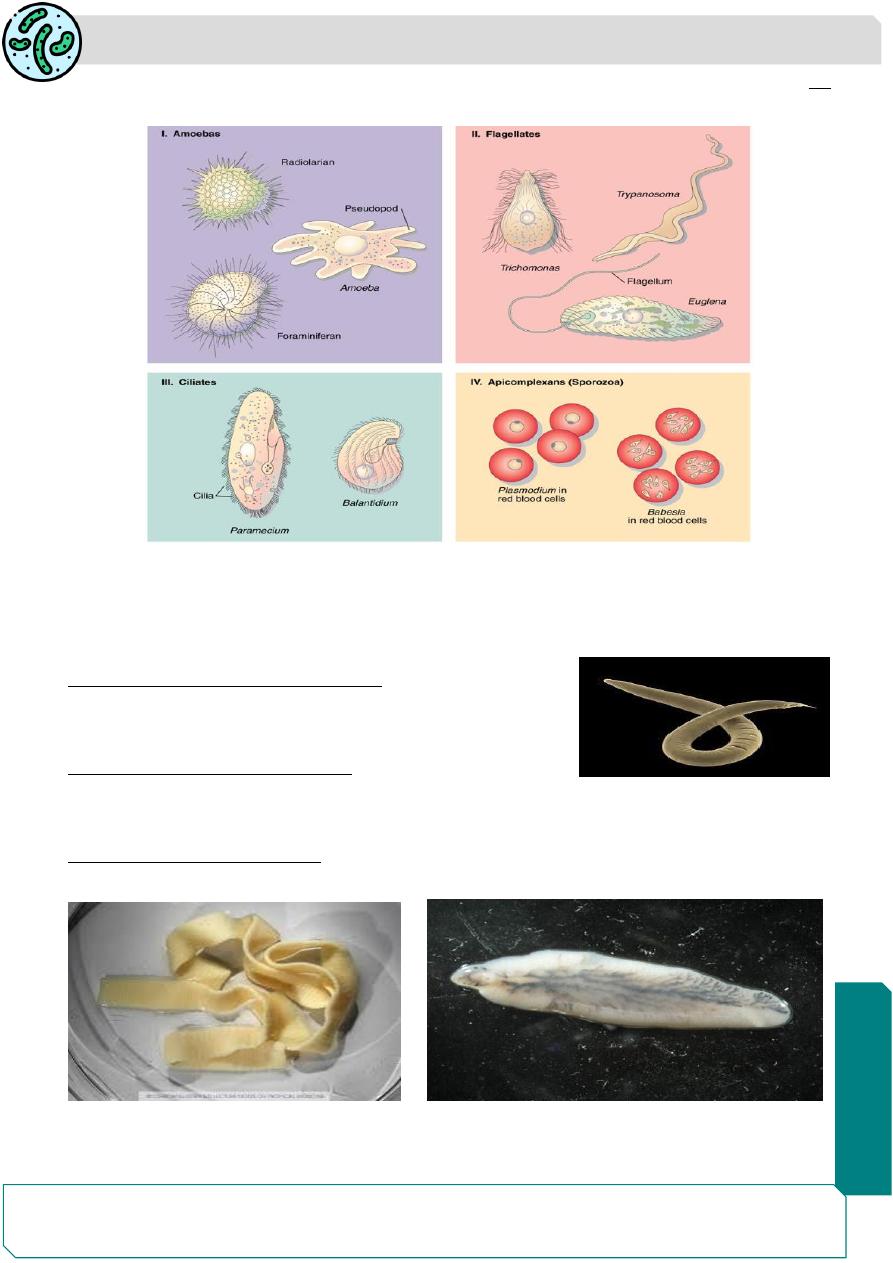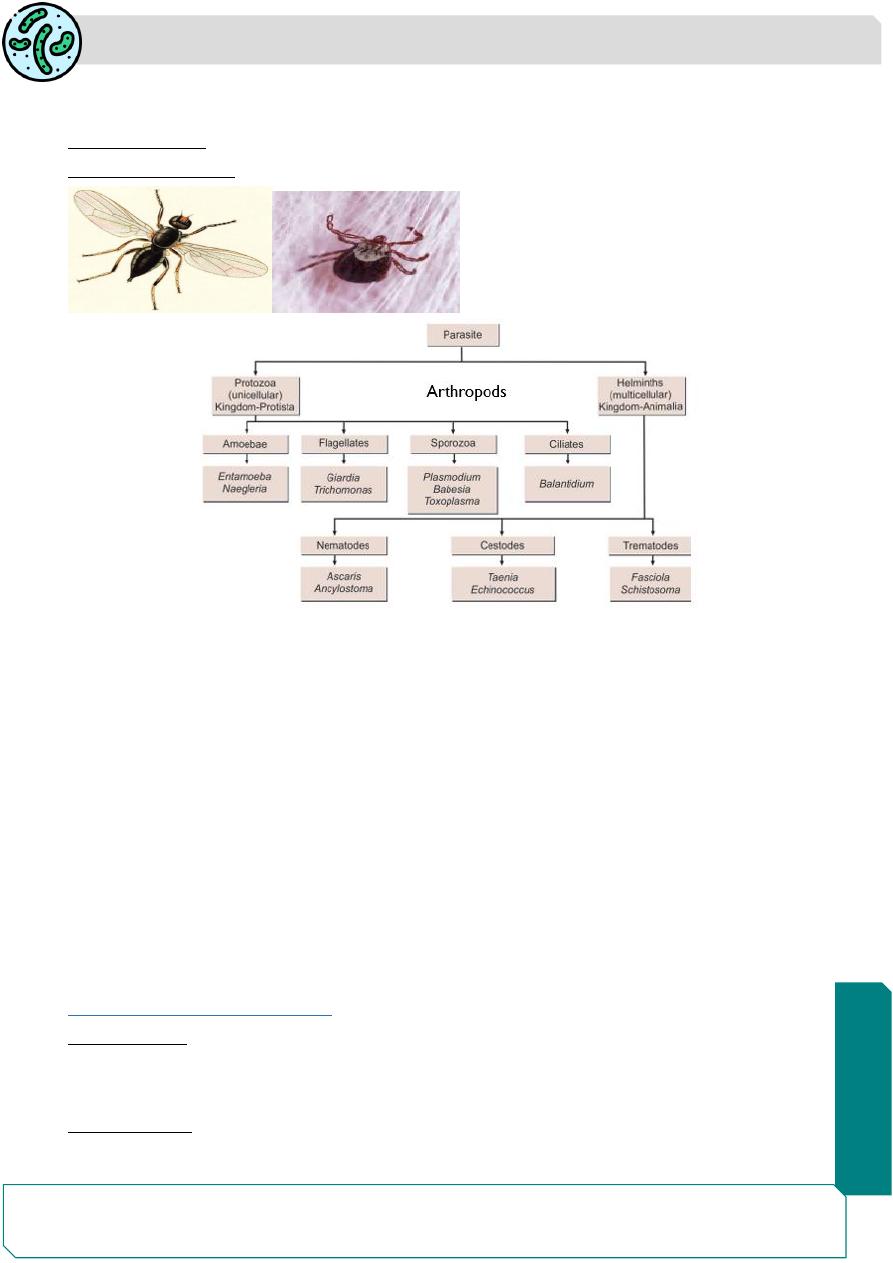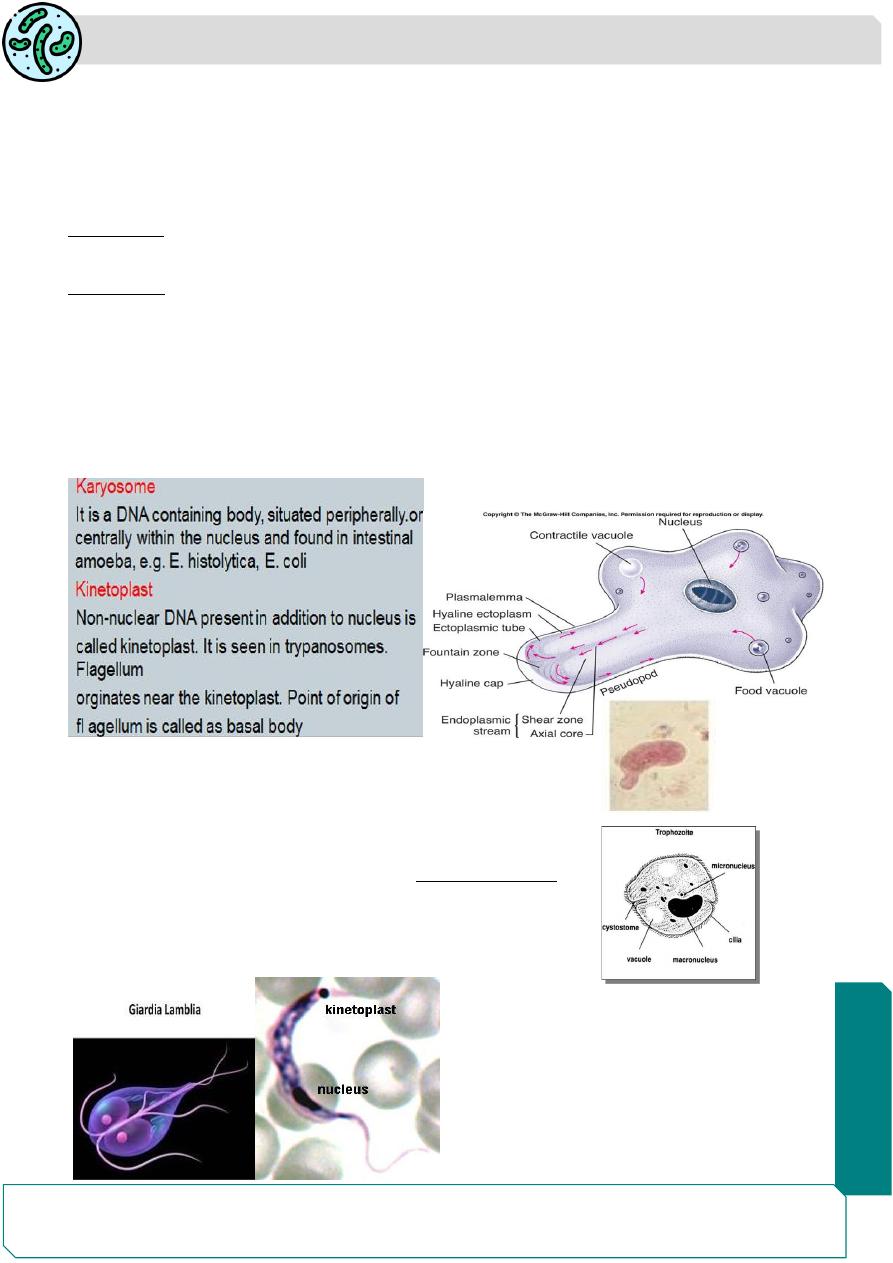
Parasitology
Notes…
1
Parasitology Lecture.1
Parasitology :
is a branch of science that deals with the study of parasites
Or (is the science study the relationship between two (organisms one called parasite
& the other is called the host
Human parasitology, an important part of parasitology, study the medical parasites
including their morphology, life cycle , the relationship with host and environment
Parasites :
are living organisms, which depend on a living host for their nourishment and shelter
temporarily or permanent and living in or on another organism .
Some time parasite multiply or undergo development in the host
CLASSIFiCATION OF PARASITES:
The parasites in medical pasitarogloy are
1- Protozoa. 2- Helminthes 3- Arthropods
-Protozoa (unicellular).
-Metozoa(Multicellular)Helminth, arthropods
Kingdom . Phylum. Class. Order. Family .Genus . species
scientific parasitic name is of 2 parts: Genus name and species name. ex:
Plasmodium falciperum
Entamoeba histolytica
I- Protozoa :
unicellular ,eukaryotic parasites , some are pathogenic others are non pathogenic or
have free living cycles.
Protozoa (unicellular). Mainly in 2 stage:
1-Trophozoite - (active, feeding ,pathogenic stage )
2-Cyst/ oocyst -unactive and infective form
Protozoa divided into 4 classes according to the organ of locomotion:
1- Class sarcodina(Amoebas):
Parasites that move by means of pseudopodia example Entamoeba histolytica.
2-Class mastigophora (Flagellates):
Parasites that move by means of flagella
example
Giardia lamblia ,Trichomonas vaginalis
3- Class ciliates(ciliata) :
parasites that move by means of cilia
example
Balantidium coli .
4- Class Sporozoa : parasites have both sexual and asexual reproductive organs.
N
eed S
om
e H
el
p?

Parasitology
Notes…
2
All sporozoa are parasitic and all these parasites are intracellular and they have no
organ of locomotion. ex. Plasmodium parasites causing malaria.
II- Helminthes :
They are metazoa ( Multicellular parasite ).
they differ from protozoa in their inability to multiply in the body of the host.
Helminthes divided into 3 classes :
1.Class Nematoda ( Roundworms ) :
worm-like, separate-sexed, unsegmented roundworms
Example: Intestinal nematodes,
Ascaris and Enterobius
.
2 -Class Cestoda ( Tapeworms) :
The tapeworms of humans are band-like and segmented worms, e.g:
Taenia spp
,
Echinococcus
.
3- Class Trematoda (Flukes):
They are flattened ,unsegmented , leaf- shaped worms. e.g: blood flukes
.
2 3

Parasitology
Notes…
3
III- Arthropods :
These parasites having exoskeleton and jointed legs, divided into 2 classes:
1- Class Insecta :e.g. Mosquitoes, housefly.
2- Class Arachnida :e.g. spiders,Ticks and mites .
GENERAL TERMINOLOGY
symbiosis (association-relationship of two or more organisms living together)
1-
Mutualism: two organisms living together, the two organisms benefit(bacteria in the
bowel)
2-
Commensalism:(eating on the same table) two organisms living together, one is
benefited and other no beneficial or not been affected.
3-
Parasitism:One organism is benefited at the expense of the another (host)
Zoonosis: disease of animals but can be transmitted to a man.
Anthroponosis: parasitic infection is found in man alone
Zooanthroponosis: parasitic infection mainly affect man, but animals become
infected in life cycle of parasite like in taeniasis
Anthropozoonosis:parasitic infection is mainly in animals, some time may be
acquired by man as in echinococcosis
Parasites can be classified as:
-Ectoparasite: a parasite lives outside on the surface of the body host without
penetrating the tissue. like Lice, ticks, and mites
The term infestation used with ectoparasites.
-Endoparasite: parasite lives inside the body of the host .like Toxoplasma gondii and
Plasmodium. the term infection used with endoparasite.

Parasitology
Notes…
4
-Most of the protozoan and helminthic parasites causing human disease are
endoparasite
Parasites can be classified into:
Permanent parasite : remains in the host for life and can not survive without the host
Temporary parasite : Visits a host for a short period for food (soft ticks).
Obligate parasite: Parasite that cannot survive outside of a host e.g. Trichomonos
Facultative parasite: parasites able to live both free living and parasite living under
unfavorable enviromental condition e.g. Strongyloides species
Accidental parasites: which infect an unusual host and survives, but may or may not
comp;ete life cycle.
Echinococcus granulosus infects man accidentally, giving rise to hydatid cysts humans
opportunistic parasite :produces disease and severe pathological lesions only in
immunodeficient or immunosuppresed patients(AIDS) but in immunocompetent
individuals producing mild or no diseases.
Wandering or Aberrant parasite : Parasite reaches a place
where it can not live.
Pseudoparasite: not a true parasite but mistaken as parasite (called artifact) this is
include yeast, hairs, spores
Coprozoic parasite : The organisms that have been accidental ingested and passed
through the intestine without causing any infection to the host.
Host
is defined as an organism, which provides shelter and food to other organism small
than the host in size.
Definitive host
: Host in which the adult sexual phase of parasite development occurs .e.g.
mosquito acts as definitive host in malaria.
The definitive host may be a human or any other living being.
Intermediate host:
Host in which the larval asexual phase of parasite development
occurs .
In some parasites, 2 different intermediate hosts may be required to complete different
larval stages.these
are known as first and second intermediate hosts,
respectively.€
Carrier host:
A person or animal with asymptomatic infection that can be transmitted to
another susceptible person or animal
Reservoir host :
a continuous source of infection, reservoirs can be human ,animals or
non living things
Accidental host:
in which the parasite is not usually found, e.g. man is an accidental host
for cystic echinococcosis

Parasitology
Notes…
5
Life Cycle of Parasites
Direct life cycle
: When a parasite requires only
Single host to complete its development.e.g. Entamoeba histolytica requires only a
human host to complete its life cycle.
Indirect life cycle
: When a parasite requires 2 or more species of host to complete its
development, e.g. malarial parasite requires both human host and mosquito to complete
its life cycle
Sources of Infection
1-Contaminated soil and water:
- Soil polluted with embryonated eggs (roundworm, whipworm) may be ingested or
infected larvae in soil, may penetrate skin ,in water may be ingested (cyst of amoeba
and Giardia
- Free living parasites in water may directly enter through nasopharynx (Naegleria)
2-food:
Ingestion of contaminated food or vegetables containing infective stage of parasite
(amoebic cysts, Toxoplasma oocysts, Echinococcus eggs)

Parasitology
Notes…
6
3-Insect vectors:
A vector is an agent, usually an arthropod that transmits an infection from man to man
or from other animals to man, e.g. female Anopheles is the vector of malarial parasite.
Vectors divided into
a- Biological vectors (true vectors):
which not only assists in the transfer of parasites
but the parasites undergo development or multiplication in their body as well.
Mosquito—Malaria
b-Mechanical vectors
:which assists in the transfer of parasitic form between hosts but
is not essential in the life cycle of the parasite.
Housefly—amoebiasis
4-Domestic animals:
ˆ Cow, e.g. T. saginata,
ˆ Pig, e.g. T. solium, Trichinella spiralis
ˆ Cat,e.g. Toxoplasma
ˆ Dog, e.g. Echinococcus granulosus
5-Self (autoinfection)
€ Finger to mouth transmission, e.g pinworm
Modes of Infection
1-Oral transmission: The most common method of transmission is through oral route by
contaminated food, water.
2-Skin transmission: Entry through skin is another important mode of transmission.
3-Vector transmission: Many parasitic diseases are transmitted by insect bite
4-Direct transmission: Parasitic infection may be transmitted by person to person
contact in some cases.
5-Vertical transmission: Mother to fetus transmission may take place in malaria and
toxoplasmosis.
6-Iatrogenic transmission: It is seen in case of transfusion malaria and toxoplasmosis
after organ transplantation.
Pathogenesis
Parasitic infections may remain inapparent or give rise to clinical disease.
Pathogenic mechanisms, which can occur in parasitic infection are
1-Lytic necrosis:Enzymes produced by some parasite can cause lytic necrosis.
2- Trauma :Attachment of hookworms on jejunal mucosa .
3-Allergic manifestations :Clinical illness may be caused by host immune response to
parasitic Infection.
4-Physical obstruction: Masses of roundworm cause intestinal obstruction
5-Inflammatory reaction: Clinical illness may be caused by inflammatory changes and
fibrosis.

Parasitology
Notes…
7
6-Neoplasia: A few parasitic infection have been shown to lead to malignancy
Pathogenesis of the parasitic diseases depend on
A-Host factors :
1) Nutritional status of the host, whether malnutrition or under nutrition.
2) Immune status of the host whether there is immuno-suppression or not.
3) The presence or absence of the co-existing disease or other physiological conditions
such as pregnancy
4) The age and level of the immunity at the time of infection
B-Parasitic factors :
1) Site of the parasite .
2) Number of invading parasites.
3) Parasite strain(pathogenic or non-pathogenic) and the growth, development and
multiplication of parasites
Diagnosis of parasitic diseases depends on
A) history and Clinical features : like fever, pain
b) Laboratory diagnosis
1-Microscopy 2-Culture
3- Serological test 4-Skin test
5-Molecular method 6- Animal inoculation
7-Xenodiagnosis 8-Imaging
9- Hematology
1-Microscopy
An appropriate clinical specimen should be collected for definitive diagnosis of parasitic
infections.
Stool, Blood, Urine, Sputum, Cerebrospinal fluid (CSF), Tissue and aspirates,
Genital specimens.
Immunity in Parasitic Infection
Like other infectious agents, parasites also elicit immunoresponses in the host, both
humoral as well as cellular
But immunological protection against parasitic infections is much less effi cient, than it
is against bacterial or viral infections.
parasites are larger or more complex structurally and antigenically, so that immune
system may not be able to focus attack on the protective antigens.
Many parasites are intracellular or in body cavity in location, and this protects them
from immunological attack.
Vaccination
No eff ective vaccine for humans has so far been developed against parasites due to
their complex life cycles, adaptiveresponses, and antigenic variation

Parasitology
Notes…
8
protozoan Structure
The typical protozoan cell is bounded by simple unit membrane, supported by a sheet of
contractile fibrils
Cytoplasm
It has 2 portions:
Ectoplasm: Outer homogeneous part that serves as the organ for locomotion and for
engulfment of food by producing pseudopodiais,excretion and cyst formation.
Endoplasm: The inner granular portion of cytoplasm
Is concerned with metabolismand reproduction includes the following structures(
nucleus ,the golgi bodies, endoplasmic reticulum, food vacuoles, and contractile
vacuoles).
Nucleus
The nucleus is usually single but may be double or multiple;
The nucleus contains one or more nucleoli or a central karyosome.
Pseudopod: A protoplasmic extension on the trophozoites
of amoeba allowing them to move and engulf food .
Cilia: Hair like processes attached to a free surface of a
cell; function for motility of the cell, e.g. Balantidium coli .
*Flagellum(flagella) : An extension of ectoplasim which
provides locomotion similar to a tail .
